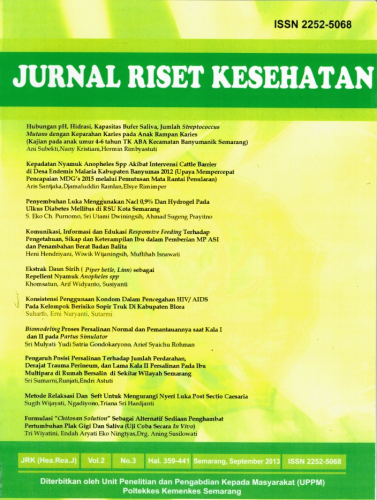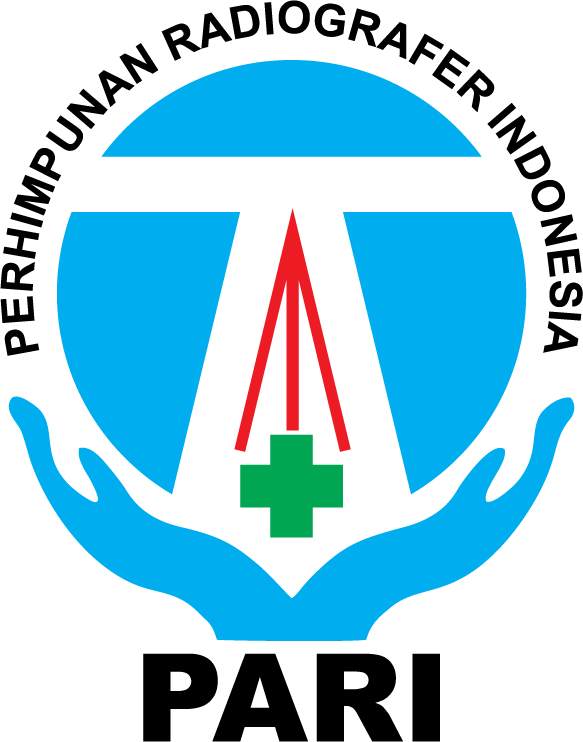ANALYSIS OF FAMILY PLANNING DROPOUTS IN WOMEN OF REPRODUCTIVE AGE
Abstract
The Family Planning Program (FPP) is one of the strategies carried out by the government to suppress the increase in population growth. Unfortunately, women of reproductive age (WRA) often stop participating in FPP or drop it out, unaware of increasing the risk of conception. This study uses secondary data from the 2017 IDHS for 945 WRAs who have used modern FPP methods. It uses cross-tabulation to determine the distribution of husbands' approval regarding the FPP method, wanting more children, side effects of family planning, the role of family planning service providers, and the incidence of dropping out of FPP in North Sumatra Province. The results indicated that 238 out of 707 WRAs (25.8%) dropped out of FPP. The FPP dropping out in North Sumatra Province mostly occurred to WRAs who experienced side effects of FPP methods (238 WRAs) and who changed their minds to want more children (67 WRAs). The BKKBN of North Sumatra Province must provide training to FPP service providers on the side effects of the methods to improve their counseling skills, which must be used properly to serve the WRAs before they decide to use contraceptives.
Keywords
Full Text:
PDFReferences
Alayubi, M. S. (2018). Faktor Penyebab Banyaknya Jumlah Anak pada PUS Keluarga Nelayan di Desa Subang Jaya Kecamatan Bandar Surabaya Kabupaten Lampung Tengah Tahun 2016.. Universitas Lampung.
Apolonia. (2018). Gambaran Tingkat pengetahuan Akseptor KB Hormonal tentang Efek Samping Kontrasepsi Hormonal di Puskesmas Gentungan Jabupaten Gowa tahun 2018. Jurnal Farmasi Sandi Karsa, 4(7), 103–111.
Aviisah. (2018). Modern contraceptive use among women of reproductive age in Ghana: analysis of the 2003–2014 Ghana Demographic and Health Surveys. BMC Women’s Health, 18(1), 141–150. https://doi.org/10.1186/s12905-018-0634-9
Badan Pusat Statistik Provinsi Sumatera Utara. (2020). Provinsi Sumatera Utara dalam Angka 2019. Provinsi Sumatera Utara.
Bilqis, F., Nugroho, R. D., Dharmawan, Y., & Winarni, S. (2020). Hubungan Faktor Resiko Dengan Drop Out IUD di Desa Kademangaran Kecamatan Dukuhturi Kabupaten Tegal Tahun 2019. Kesehatan Masyarakat, 8, 217–226.
BKKBN. (2014a). Pedoman Pelayanan Keluarga Berencana Pasca persalinan di Fasilitas Kesehatan. Jakarta.
BKKBN. (2014b). Situasi dan Analisis Keluarga Berencana.
BKKBN. (2015). Rencana Strategis Badan Kependudukan Keluarga Berencana Nasional Tahun 2015-2019. Jakarta.
BKKBN. (2018). Survei Demografi Kesehatan Indonesia Tahun 2017 (SDKI Tahun 2017). Jakarta.
BPS. (2020). Stasistik Indonesia.
Caecilia. (2020). Efek Samping Pil KB Akseptor di Lingkungan Manyaran Kota Semarang. Cendekia Journal Of Pharmacy, 4(2), 175–184.
Cohen, R., S. (2017). Factors Associated With Contraceptive Method Choice and Initiation in Adolescents and Young Women. Journal of Adolescent Health. Journal of Adolescent Health, 6(1), 454–460.
Handayani, A. (2019). Keinginan Memiliki Anak Berdasarkan Teori Pilihan Rasional (Analisis Data SDKI Tahun 2017. Empati-Jurnal Bimbingan Dan Konseling, 6(2), 32–40. https://doi.org/10.26877/empati.v6i2.4277
Happy, M. (2021). Gambaran Pengetahuan Ibu Tentang Efek Samping Kb Suntik 3 Bulan Di Pmb Bidan Z Pamulang Barat Kota Tangerang Selatan Tahun 2019. Journal of Midwifery Science and Women’s Health, 1(2), 71–76. https://doi.org/https://doi.org/10.36082/jmswh.v1i2.254
Haslan. (2020). Hubungan Penggunaan KB Implant dengan Berat Badan dan Siklus Haid Akseptor KB. Jurnal Ilmiah Kesehatan Sandi Husada, 11(1), 347–352. https://doi.org/10.35816/jiskh.v11i1.279
Hawkins. (2016). The Association Of Attitudes About Contraceptives With Contraceptive Use In A Random Sample Of Colorado Women. The Social Science Journal, 5(8), 167–173.
Ismah, Z. (2021). Survey Penggunaan Kontrasepsi Serta Jumlah Anak Pada PUS di Kota Medan. Contagion : Scientific Periodical of Public Health and Coastal Health, 3(1), 54–64. https://doi.org/10.30829/contagion.v3i1.9371
Khairunnisa, M. (2015). Hubungan Antara Sebaran Informasi Kampanye dengan Tingkat Keikutsertaan Pasangan Usia Subur ( PUS) dalam Program Pengendalian Kelahiran Anak (KB) Di Kelurahan Ujana, Kota Palu. Jurnal Komunikasi KAREBA, 4(4), 468–481.
L.Nelson, A. (2018). Women’s perceptions and treatment patterns related to contraception: results of a survey of US women, Contraception. Contraception, 97(1), 256–263. https://doi.org/https://doi.org/10.1016/j.contraception.2017.09.010
Nurjannah. (2017). Determinan Kejadian Drop Out Penggunaan Kontrasepsi Pada Pasangan Usia Subur (PUS) Di Kabupaten Kuningan. Jurnal Ilmu Kesehatan Bhakti Husada: Health Sciences Journal, 6(2), 1–9.
Purwaningrum. (2017). Efek Samping KB IUD (Nyeri Perut) dengan Kelangsungan Penggunaan KB IUD. Kesehatan, 5(1), 45–51.
Septalia. (2017). Faktor Yang Memengaruhi Pemilihan Metode Kontrasepsi. Unnes Journal of Public Health, 6(3), 167–173.
Setiawati. (2017). Pemilihan Kontrasepsi Berdasarkan Efek Samping Pada Dua Kelompok Usia Reproduksi. Unnes Journal of Public Health, 6(3), 167–173.
Siregar, P. A. (2021). The Role Of Midwives And Participation Of Postpartum Mothers In Postpartum Family Planning. Jurnal Kebidanan Dan Kesehatan Tradisional, 6(2), 62–73. https://doi.org/https://doi.org/10.37341/jkkt.v0i0.252
Sitorus, M. A. (2020). Analisis Preferensi Jumlah Anak Ideal di Provinsi Sumatera Utara ( Analisis Data Skunder SDKI 2017). Contagion : Scientific Periodical of Public Health and Coastal Health, 2(2), 87–98. https://doi.org/10.30829/contagion.v2i2.7989
Sitorus, M. A. (2021). Pengaruh Frekuensi Media dan Keterpaparan Informasi tentang KB terhadap Persepsi Jumlah Anak Ideal: Analisis Data SDKI 2017. Jurnal Kesehatan, 14(1), 84–94. https://doi.org/10.24252/kesehatan.v14i1.16929
Sumartini. (2017). Pengaruh Keinginan Pasangan Usia Subur (Pus) dalam Penggunaan Metode Kontrasepsi Jangka Panjang. Jurnal Biometrika Dan Kependudukan, 5(1), 27–37. https://doi.org/https://doi.org/10.20473/jbk.v5i1.2016.27-34
Weni, L. (2019). Determinan Pemilihan Metode Kontrasepsi Jangka Panjang Pada Akseptor KB Aktif di Puskesmas Pedamaran. Contagion : Scientific Periodical of Public Health and Coastal Health, 1(1), 9–16. https://doi.org/10.30829/contagion.v1i01.4819
DOI: https://doi.org/10.31983/jrk.v11i1.8449
Article Metrics
Refbacks
- There are currently no refbacks.
Copyright (c) 2022 Jurnal Riset Kesehatan














































